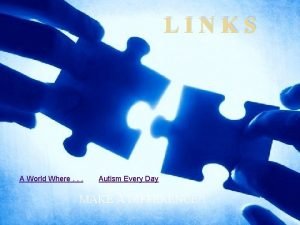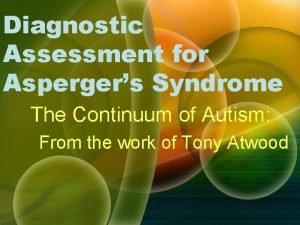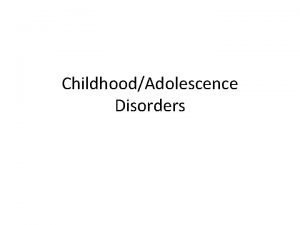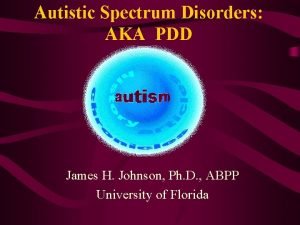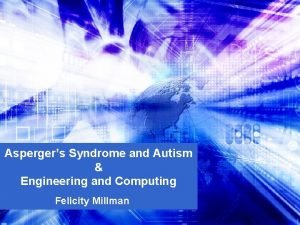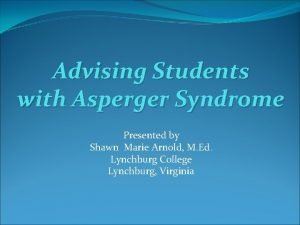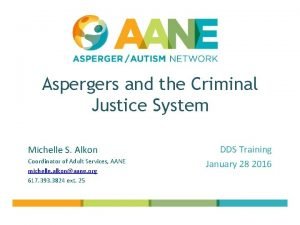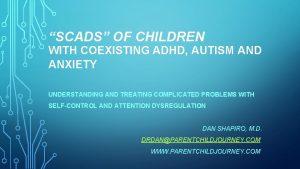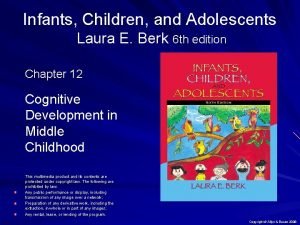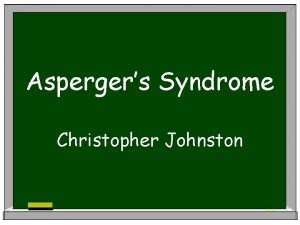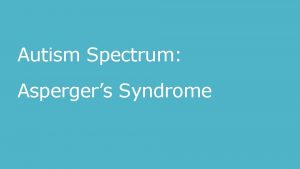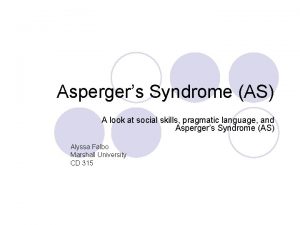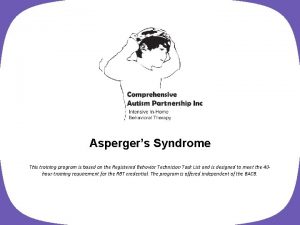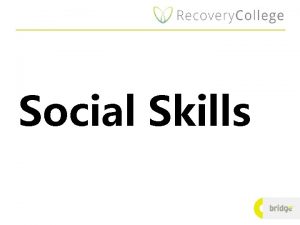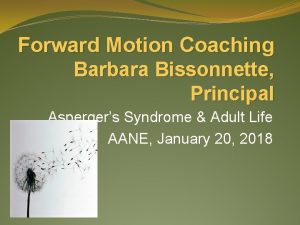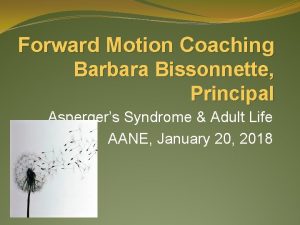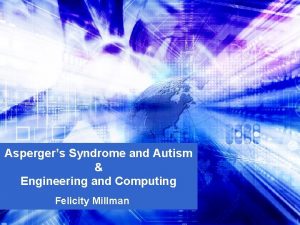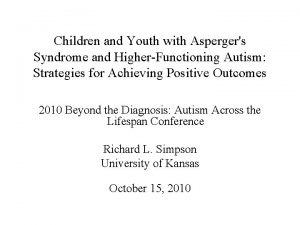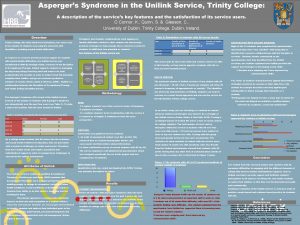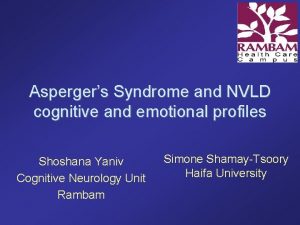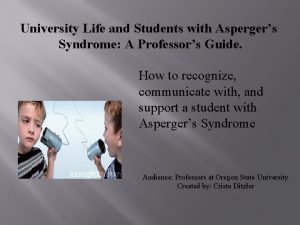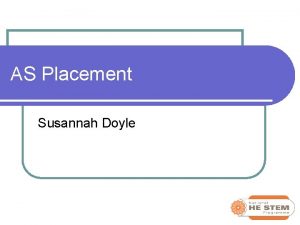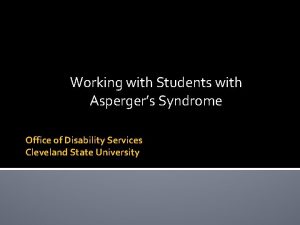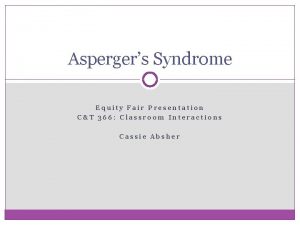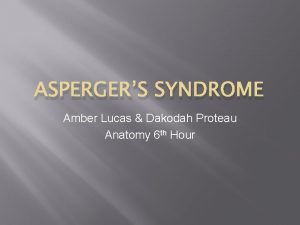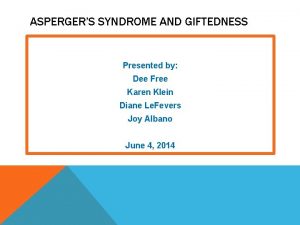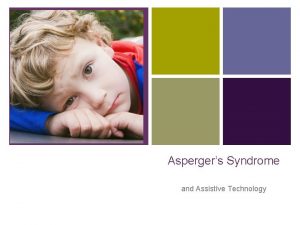SOCIAL SKILLS TRAINING FOR ADOLESCENTS WITH ASPERGERS SYNDROME













































































- Slides: 77

SOCIAL SKILLS TRAINING FOR ADOLESCENTS WITH ASPERGER’S SYNDROME AND HIGH-FUNCTIONING AUTISM Leslie Sachs and Noelle Law, Fall 2010

WORKSHOP OUTLINE General Topic Outline and Workshop Goals Purpose Statement Introduction Background Information Key Deficits in individuals with AS/HFA Important Considerations Definition of Aspergers Definition of high-functioning autism

WORKSHOP OUTLINE What? Definition of Social Skills Social Deficits for individuals with AS/HFA General Skill deficits Associated Deficits Issues Associated with Social Skill Deficits Specific Social Skill Topics that are Relevant

WORKSHOP OUTLINE How? Social Skill Training Methods Comparison of Different Training Methods Screening and Placement Procedures for Social Skill Training Rating Scales Questionnaire

WORKSHOP OUTLINE Why? Supported social skill improvements for adolescents Improved social skill outcomes for adults A comparison of individuals with and without social skill training.

GENERAL TOPIC OUTLINE: The following are the general goals of this workshop: What social skills are important to cover for adolescents with AS/HFA. How social skills can be taught, including different programs and approaches. Why there is a need to continually research and explicitly teach social skills to adolescents with AS/HFA.

PURPOSE STATEMENT: Adolescents diagnosed with AS/HFA need to be provided appropriate social skill training in order to guide them in being more independent as well as aide them in a successful adult transition. (Willey and Jackson, 2003). In order to do so, attention needs to be paid to what the specific social skills needs of adolescents with AS/HFA are and what the best programs and approaches include.

INTRODUCTION: Background: In recent years there has been a lot of attention and research dedicated to Autism Awareness and intervention (Lord and Bishop, 2010). There has also been a focus on the specific needs of individuals with Asperger’s and High-Functioning Autism. (Koyma, Tachimori, Osada, Taked, and Kurita, 2007). It wasn’t until recently that concern was raised regarding how the specific needs of adolescents diagnosed with AS/HFA can be met.

KEY DEFICITS IN INDIVIDUALS WITH AS/HFA In comparison to the general characteristics and deficits of individuals diagnosed with Autistic Spectrum Disorder, the prominent areas of concern for individuals with AS/HFA include: Social Interaction Peer Communication (Ozonoff, Dawson, and Mc. Partland, 2002).

IMPORTANT CONSIDERATIONS Aspergers The term Aspergers is often associated with individuals that meet the appropriate developmental milestones but exhibit social and behavioral impairments similar to the characteristics of Autism. Additionally, these individuals with Aspergers are often classified as having average to above average IQ’s with possible associated features of impaired motor coordination and planning difficulties (Klin, Mc. Partland, and Volkmar, 2005).

IMPORTANT CONSIDERATIONS CONTINUED High-Functioning Autism Individuals described as having HFA share characteristics of both “classic autism” and Aspergers syndrome. While there is no specific diagnostic criteria for HFA, the closest classification states that HFA includes meeting the DSM criteria for autism as well as having a IQ that is within the low average to average range. Additionally, individuals with HFA may also exhibit odd social mannerisms, childlike communication styles and display specific interests that are rare or unique. (Sansosti and Powell-Smith, 2010).

WHAT?

DEFINITION OF SOCIAL SKILLS Social skills can be described as “being a multifaceted set of obvious and concealed behaviors, which optimize the likeliness of developing, maintaining, or improving social proficiency or status by supporting an ability to create positive interactions with others” (Bellini, 2006, p. 140).

TRIAD OF SOCIAL SKILL DEFICITS The triad of impairments refers to impairments in: social relationships social communication imagination

GENERAL SOCIAL SKILL DEFICITS IN ADOLESCENTS WITH AS/HFA Reciprocity Initiation of interactions Ability to infer the interests of others Maintenance of eye contact Ability share enjoyment and empathy Decoding facial expressions

RELATED SOCIAL SKILL DEFICITS Theory of Mind (To. M) is the ability to understand anticipate other people’s opinions or emotions based on external behavioral cues and circumstances (Baron-Cohen, 1995). Social Reciprocity is described as the back-andforth flow of social interaction or how the behavior of one person influences and is influenced by the behavior of another person and vice versa. As well as the mutual responsiveness in the context of interpersonal contact, such as awareness of and ability to respond appropriately to other people. (p. 161)

ISSUES FOR ADOLESCENTS RELATED TO SOCIAL SKILL DEFICITS Three common issues in adolescents that are linked to deficits in social skills include: Increased levels in: Anxiety Peer Bullying Depression It is a well known fact that adolescence is a time when peer groups and relationships become increasingly important. The high levels of stress and anxiety individuals with AS/HFA develop related to social situations, defers them from seeking and creating meaningful social relationships.

SOCIAL SKILL NEEDS OF ADOLESCENTS WITH AS/HFA Navigating adolescence for any teen is a challenge. It is a time when many changes occur including: Physical Psychological Social Change Adolescents with AS/HFA are battling the same pubescent issues as all teenagers during these years. However, adolescents with AS/HFA have additional social skills deficits that make this time increasingly challenging and stressful. (Patrick, 2008, p. 16).

GROUP ACTIVITY # 1 Take 10 -15 minutes to discuss with your table group/team what types of social situations, interactions, and topics you think would be important to address for adolescents with Aspergers and high-functioning autism. After completing the activity please take a 10 min break as well.

SPECIFIC SOCIAL SKILL TOPICS RELEVANT TO ADOLESCENTS WITH AS/HFA Typical Adolescent Social Situations Dating and Interacting with similar age peers of interest Understanding Physical Changes of the body Peer Problem Solving Appropriate Social and Behavioral Expectations at School

TYPICAL ADOLESCENT SOCIAL SITUATIONS

TYPICAL ADOLESCENT SOCIAL SITUATIONS Social Situations that need to be covered for adolescents with AS/HFA include situations that are typical to all teens. Handling peer pressure Drug and Alcohol exploration Dating Pursuing a driving license and the responsibilities of driving Decision making Determining self identity

DATING AND INTERACTING WITH PEERS OF INTEREST

DATING AND INTERACTING WITH PEERS OF INTEREST These social anxieties surrounding dating are inflated for adolescents with AS/HFA. “Individuals with AS have the same interests and sexual needs as the general population; however, their mode of expression is different. Their communication difficulties add to the obstacles that they encounter when establishing interpersonal and sexual relationships” (Henault and Attwood, 2006, p 11). There is limited research addressing the need to explicitly cover issues related to dating and the sexuality of adolescents with AS/HFA. However, these issues can have a negative impact on an individuals education and therefore need to be covered in a structured and systematic way that is appropriate for the school setting.

UNDERSTANDING PHYSICAL CHANGES OF THE BODY

UNDERSTANDING PHYSICAL CHANGES OF THE BODY Physical and hormonal changes: While these may not seem like social skills directly, developing an understanding of body changes and the need for regimented hygiene relates to many of the struggles individuals with AF/HFA face in relation to teen social situations. Difficulties with body image and hygiene become social skills when an adolescent is: trying to fit in develop friendships seek out desired relationships build self confidence.

PEER PROBLEM SOLVING

PEER PROBLEM SOLVING Tension and difficulties among peers can cause a host of negative emotions for adolescents. Embedded in the social skill of problem solving is the ability to appropriately handle anger and manage stress when confronted or interacting with others. Peer Problem Solving skills to cover: A focus on self-awareness of feelings Promote self calming techniques Anger and frustration control Stress management

APPROPRIATE SOCIAL AND BEHAVIORAL EXPECTATIONS AT SCHOOL

APPROPRIATE SOCIAL AND BEHAVIORAL EXPECTATIONS AT SCHOOL At the same time adolescents with AS/HFA are going through emotional, physical, and social change, they are also expected to go to school, follow the rules, and get passing grades. Expectations to cover for school success include: Understanding the use of informal greetings. Realizing the the significance of paying attention in class. Learning how to ask for help when needed. Understanding the importance of completing work and assignments. Instruction how to use organizational skills and being prepared for class.

GROUP ACTIVITY #2 Take 20 -30 minutes to plan with your table group/team what students you might plan on serving and what topics you think would be the most appropriate to cover for the group of students identified. Questions to keep in mind: How many students? How many groups? After completing the activity please take a 10 min break as well.

HOW?

FOUR METHODS MOST RELEVANT TO SCHOOL PSYCHOLOGISTS 1. 2. 3. 4. Social stories Social groups Cognitive behavioral therapy (CBT) Virtual environments (VE’s) What will be covered: 1. Definition 2. Research 3. Benefits 4. Challenges

1. SOCIAL STORIES

SOCIAL STORIES (WHAT ARE THEY? ) Background: Created in 1993 by Carol Gray (Rust & Smith, 2006). Brief, written in first person, and paper format Focuses on: When to do a behavior How to do a behavior Why to do a behavior Evolution: Before all data on one page Now paragraphs on one page Computer based Not correlated with Gray’s 1998 guidelines

SOCIAL STORIES (WHAT ARE THEY? ) Four types of sentences (Scattone, Wilczynski, Edwards, & Rabian, 2002): Perspective Directive (Rust & Smith, 2006) Affirmative Descriptive Gray specified a ratio of 2 – 5 descriptive, perspective, and/or affirmative statements for every 1 directive statement (Scattone et al. , 2002).

SOCIAL STORIES (RESEARCH CASE) Bob (Scattone et al. , 2002). 15 -year-old male Inappropriately stares at females Reads social story one hour before recess every day

SOCIAL STORIES (RESEARCH CASE) There are lots of girls at school. Sometimes I see girls in my classroom. Sometimes I see girls in the hallways. Sometimes I see girls at pep rallies. Sometimes I see girls at recess. It’s OK to look at girls. When I look at a girl for a long time, she may get mad or sad. When I look at a girl, I will count slowly to two and then I will try to look at something else. I should try to look at some-thing else until I slowly count to ten. After I slowly count to ten, I can look at the girl again if I want to. Comprehension Questions: Is it OK to look at girls? How long should I look at a girl for? When I look away, what should I count to? (Scattone et al. , 2002, p. 542)

SOCIAL STORIES (RESEARCH CASE) Staring begins 66. 9% of intervals After social story: Session 1 – 42% of intervals Session 10 – 58% of intervals Session 11 – 26% of intervals Session 17 – 0% of intervals

SOCIAL STORIES (BENEFITS) Timing Routine Safe Visual component Non-intrusive May be most beneficial at reducing inappropriate behaviors (Kokina & Kern, 2010).

SOCIAL STORIES (CHALLENGES) Preparation (Rust & Smith, 2006) Usually cannot be generalized Can be expensive May or may not be enjoyable

GROUP ACTIVITY #3 SOCIAL STORIES You will be creating your own social story! Option to work individually or in groups Steps: Grab a pen and take as much paper as you want. Spend 2 minutes choosing a specific social skill you’d like to focus on. Spend 1 minute choosing what general age group you’d like to focus on. Spend 2 minutes figuring out the general “when, how, and why” of the behavior. Spend 5 minutes drafting on a piece of scratch paper the perspective, directive, affirmative, and descriptive sentences. Spend 5 minutes writing the final sentences on one piece or several pieces of paper. Spend 5 minutes drawing stick figure drawings for each page you have (just stick figures!) Get ready to quickly show off your first social story creation!

SOCIAL STORIES (ACTIVITY #3 REMINDERS) Four types of sentences: Perspective Directive Affirmative Descriptive Ratio of sentences can be up to you Brief, written in first person Focuses on: When to do a behavior How to do a behavior Why to do a behavior Bob’s Example: There are lots of girls at school. Sometimes I see girls in my classroom. Sometimes I see girls in the hallways. Sometimes I see girls at pep rallies. Sometimes I see girls at recess. It’s OK to look at girls. When I look at a girl for a long time, she may get mad or sad. When I look at a girl, I will count slowly to two and then I will try to look at something else. I should try to look at some-thing else until I slowly count to ten. After I slowly count to ten, I can look at the girl again if I want to.

2. SOCIAL GROUPS

SOCIAL GROUPS (WHAT ARE THEY? ) Typically 6 – 8 adolescents per group (Tse, Strulovitch, Tagalakis, Meng, & Fombonne, 2007) Group rules Individual teaching Weekly sessions Skills practice Role-play “Joke time” Field trips Focus: Create safe opportunities for practice and learning with real peers A variety of forms

SOCIAL GROUPS (RESEARCH CASE) 2007 research case (Tse et al. ): 46 adolescents divided into groups of 7 or 8 12 sessions over 12 weeks Led by psychologist and social worker Sessions were 60 – 90 minutes after school

SOCIAL GROUPS (RESEARCH CASE) 1. Check-in. Each member discusses events and problems from their week. Other members are encouraged to ask questions and offer suggestions. 2. Review of last week’s skill: Leaders ask if members had a chance to practice the previous skill. 3. Intro of new skill. Members are asked to talk about their ideas on a particular social skill. Members may be given a card describing the new skill. 4. Role play. Members practice the new skill in pairs, one pair at a time, while the rest of the group watches and gives feedback. 5. Snack break. Members are encouraged to interact with one another during the break. 6. Game. Group games such as charades are played. 7. Closing. Members are encouraged to say goodbye to each other. (Tse et al. , 2007, p 1962).

SOCIAL GROUPS (RESEARCH CASE) Restaurant field trip Final session celebration Alumni parties

GROUP ACTIVITY #4: Break up into groups of 3. Appoint a time keeper, a recorder, and a presenter. Discuss for 7 minutes other field trip options. Each group presents their ideas for 3 minutes while an electronic list is being created. Spend the same amount of time (7 minutes brainstorming and 3 minutes presenting) for other options for celebrations and keeping in touch. Examples: 1. Restaurant field trip 2. Celebration on final session 3. Alumni parties Please note that the final list of ideas will be e-mailed to all presentation attendees to be used as a resource for future social groups.

SOCIAL GROUPS (RESEARCH CASE) Results: Social Responsiveness Scale (SRS) Aberrant Behavior Checklist (ABC) Nisonger Child Behavior Rating Form (N-CBRF) Scores demonstrated effect sizes for subscales to be statistically significant: . 34 to. 46 for the SRS/N-CBRF and. 34 to. 72 for the ABC (Tse et al. , 2007, p. 1962).

SOCIAL GROUPS (BENEFITS) Friendships are usually within a group (Orsmond, Krauss and Seltzer, 2004) Professionally feasible Parent modeling Flexibility: Topics were covered in a flexible manner Pace was determined by needs of group

SOCIAL GROUPS (CHALLENGES) Parents report “little” overall improvement (Tse et al. , 2007, p. 1965). Difficulty with generalization Lack of curriculums

3. COGNITIVE BEHAVIORAL THERAPY (CBT)

COGNITIVE BEHAVIORAL THERAPY (CBT) (WHAT IS IT IN GENERAL? ) CBT in regards to the general population (Burns, 1999): Examine distorted thinking Counseling Behavioral components Homework Activities Practicing Focus: Healthier feelings about themselves and situations

COGNITIVE BEHAVIORAL THERAPY (CBT) (WHAT IS IT WITH AS/HFA? ) General: Similar to social groups in that there is variety Traditional CBT model + P ^5: Pictures Parental involvement Peer involvement Plans Practice

COGNITIVE BEHAVIORAL THERAPY (RESEARCH CASE) 2002 case study (Bauminger): 15 adolescents IEP required CBT 3 hrs/wk over 7 months Required meeting with peer 1 x a day

COGNITIVE BEHAVIORAL THERAPY (RESEARCH CASE) Roles: Teacher is supervisor Typically developing peer is to offer practice Parents are supporters and homework helpers

COGNITIVE BEHAVIORAL THERAPY (RESEARCH CASE) Results: Problem-Solving Measure by Lochman and Lampron (PSM): “More relevant solutions” and suggested fewer “nonsocial solutions” (Bauminger, 2002, p. 291) Emotional inventory: Simple emotions: Happy, sad, afraid, and angry 60% for all 4 before 100% for all 4 after Complex emotions: Pride, embarrassment, loneliness, guilt, affection, and jealousy 27% for 5 out of the 6 before 53% for all 6 after

COGNITIVE BEHAVIORAL THERAPY (RESEARCH CASE) “These findings highlight that emotions can be taught and that social understanding can be improved as an outcome of training” (Bauminger, p. 293).

CBT (BENEFITS) Generalization! Awareness of others Surpasses assigned peer

CBT (CHALLENGES) Lack of research “Handful of studies” (White et al. , 2009, p. 1653). Formal training needed

4. VIRTUAL ENVIRONMENTS (VE’S)

VIRTUAL ENVIRONMENTS (WHAT ARE THEY? ) General (Parsons, Leonard, & Mitchell, 2006): Three-dimensional Computer generated Starts out easy then gets harder Tools: Computer Mouse Joystick (optional) Supervision (optional)

VIRTUAL ENVIRONMENTS (RESEARCH CASE) Parson, et al. (2006) Adolescents John and Mike Realistic situations Bus and café scenarios Difficulty levels Feedback

VIRTUAL ENVIRONMENTS (RESEARCH CASE) Learned new social rules immediately after 1 session Retained social rules 3 -months afterwards John generalizes!

VIRTUAL ENVIRONMENT’S (BENEFITS) Video games! Short sessions Routine A lot of practice in safe environment

VIRTUAL ENVIRONMENT’S (CHALLENGES) Difficult for true tricky situations Costly May become overused

WHICH OF THE 4 METHODS IS BEST? 1. 2. 3. 4. Social stories Social groups Cognitive behavioral therapy (CBT) Virtual environments (VE’s)

Social Stories Necessary Visual Component Social Groups CBT VE’s Focuses on Generalization Ritualistic Unlimited Practice Quick Adaptability Requires Peer Social Contact Option for Parental Role Research Challenges Protocol Challenges Time Intensive Cost Intensive Training Intensive

SCREENING AND PLACEMENT PROCEDURES FOR SOCIAL SKILL TRAINING Having a consistent method to place students in a training group or to aide in selecting a social skills curriculum is essential. While research supports that there is a need to address social skills in adolescence with AS/HFA, it is also important that students are grouped according to their specific social skill needs.

RATING SCALES Social Skills Rating System (SSRS) Social Skills Improvement System (SSi. S) Recently released and revised SSRS

QUESTIONNAIRE High-Functioning Autism Spectrum Questionnaire (ASSQ). Example: This child stands out as different from other children of his/her age in the following way: No, Somewhat, Yes 1. is old-fashioned or precocious [ ] [ ] 2. is regarded as an "eccentric professor" [ ] [ ] by the other children 3. lives somewhat in a world of his/her own [ ] [ ] with restricted idiosyncratic intellectual interests

WHY?

SOCIAL SKILL IMPROVEMENTS FOR ADOLESCENTS AS A RESULT OF INTERVENTION Research indicates that direct and purposeful social skill training is effective and increasing the chance of positive outcomes for adolescents with AS/HFA. Examples: Study completed at the Montreal Children’s Hospital Child and Adolescent Psychiatry Unit. Study completed at UCLA

SUPPORTED IMPROVEMENTS IN SOCIAL SKILL ACQUISITION FOR ADULTS WITH AS/HFA While improvements are noted in adolescents that participate in various social skills trainings, positive outcomes for adults with AS/HFA are also evident. Examples: Study done by Mesibov 1984

IT WORKS Without intervention: 1. 11 -84% of children and adolescents with ASD experience impairing Anxiety (White et al. , 2009). 2. Average scores for adolescents with HFA fell in the Clinically Significant range for Withdrawal and the At. Risk range for Depression (Volker, Lopata, Smerbeck, Knoll, Thomeer, Toomey, & Rodgers, 2010). 3. “Persons with ASD are caught in a vicious circle of social isolation” (Bauminger, 2002, p. 283). With intervention: 1. “I really enjoy doing it and it may help me in the future because sometimes I have done the wrong thing” (Parsons et al. , 2006, p. 188). 2. “I think that the most powerful contribution of this intervention is the growth in my child’s self-confidence. He is much less afraid of being actively involved with peers now” (Bauminger, 2002, p. 295). 3. “Quite proud!” (Parsons et al. , 2006, p. 195).

QUESTIONS?
 Aspergers social skills training
Aspergers social skills training Whats aspergers syndrom
Whats aspergers syndrom Aspergers example
Aspergers example Aspergers assessment
Aspergers assessment Nursing diagnosis for mental retardation
Nursing diagnosis for mental retardation Aspbergers vs autism
Aspbergers vs autism Is aspergers genetic
Is aspergers genetic Strengths of aspergers
Strengths of aspergers Aspergers and criminal behavior
Aspergers and criminal behavior Aspergers vs autism
Aspergers vs autism Aspergers
Aspergers Difference between dating and courting
Difference between dating and courting Infants, children, and adolescents 8th edition
Infants, children, and adolescents 8th edition Lara berk
Lara berk Social thinking social influence social relations
Social thinking social influence social relations Social thinking social influence social relations
Social thinking social influence social relations Fspos vägledning för kontinuitetshantering
Fspos vägledning för kontinuitetshantering Typiska novell drag
Typiska novell drag Nationell inriktning för artificiell intelligens
Nationell inriktning för artificiell intelligens Vad står k.r.å.k.a.n för
Vad står k.r.å.k.a.n för Varför kallas perioden 1918-1939 för mellankrigstiden?
Varför kallas perioden 1918-1939 för mellankrigstiden? En lathund för arbete med kontinuitetshantering
En lathund för arbete med kontinuitetshantering Adressändring ideell förening
Adressändring ideell förening Tidböcker
Tidböcker Anatomi organ reproduksi
Anatomi organ reproduksi Förklara densitet för barn
Förklara densitet för barn Datorkunskap för nybörjare
Datorkunskap för nybörjare Stig kerman
Stig kerman Tes debattartikel
Tes debattartikel Delegerande ledarskap
Delegerande ledarskap Nyckelkompetenser för livslångt lärande
Nyckelkompetenser för livslångt lärande Påbyggnader för flakfordon
Påbyggnader för flakfordon Vätsketryck formel
Vätsketryck formel Offentlig förvaltning
Offentlig förvaltning Kyssande vind
Kyssande vind Presentera för publik crossboss
Presentera för publik crossboss Argument för teckenspråk som minoritetsspråk
Argument för teckenspråk som minoritetsspråk Kanaans land
Kanaans land Klassificeringsstruktur för kommunala verksamheter
Klassificeringsstruktur för kommunala verksamheter Epiteltyper
Epiteltyper Claes martinsson
Claes martinsson Cks
Cks Byggprocessen steg för steg
Byggprocessen steg för steg Mat för idrottare
Mat för idrottare Verktyg för automatisering av utbetalningar
Verktyg för automatisering av utbetalningar Rutin för avvikelsehantering
Rutin för avvikelsehantering Smärtskolan kunskap för livet
Smärtskolan kunskap för livet Ministerstyre för och nackdelar
Ministerstyre för och nackdelar Tack för att ni har lyssnat
Tack för att ni har lyssnat Referat mall
Referat mall Redogör för vad psykologi är
Redogör för vad psykologi är Stål för stötfångarsystem
Stål för stötfångarsystem Tack för att ni har lyssnat
Tack för att ni har lyssnat Borra hål för knoppar
Borra hål för knoppar Orubbliga rättigheter
Orubbliga rättigheter Formel standardavvikelse
Formel standardavvikelse Tack för att ni har lyssnat
Tack för att ni har lyssnat Rita perspektiv
Rita perspektiv Verksamhetsanalys exempel
Verksamhetsanalys exempel Tobinskatten för och nackdelar
Tobinskatten för och nackdelar Toppslätskivling dos
Toppslätskivling dos Mästare lärling modell
Mästare lärling modell Egg för emanuel
Egg för emanuel Elektronik för barn
Elektronik för barn Plagg i rom
Plagg i rom Strategi för svensk viltförvaltning
Strategi för svensk viltförvaltning Var 1721 för stormaktssverige
Var 1721 för stormaktssverige Indikation för kejsarsnitt på moderns önskan
Indikation för kejsarsnitt på moderns önskan Ro i rom pax
Ro i rom pax Tack för att ni lyssnade
Tack för att ni lyssnade Större och mindre tecken
Större och mindre tecken Dikt rim
Dikt rim Inköpsprocessen steg för steg
Inköpsprocessen steg för steg Fuktmätningar i betong enlig rbk
Fuktmätningar i betong enlig rbk Etik och ledarskap etisk kod för chefer
Etik och ledarskap etisk kod för chefer Aktiv expektans
Aktiv expektans Myndigheten för delaktighet
Myndigheten för delaktighet Frgar
Frgar

